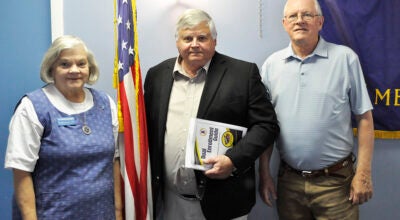Professor explains tornado behavior
Published 11:00 pm Friday, December 28, 2012
After viewing the track of what the National Weather Service is calling the Conecuh River Tornado, citizens of Pike County were left with questions and thoughts of why the tornado caused the damage it did.
Some people are saying that divine intervention played a role in the disaster, causing small damage or missing there home altogether, but a local college professor has a different take.
Nicholas D’Andrea, professor of geography at Troy University, has been studying tornadoes for more than 20 years and said that science plays a role in the way tornadoes behave.
“As these fronts are coming in and get over the area of southeast Mississippi, Louisiana and Arkansas, they start to bend towards the east,” said D’Andrea. “The alignment of the mountains is northeast/southwest and that lines right up with the way the air flow is running, so they can stay on the ground for a very long time. All tornadoes need a source of energy, and that energy comes from the Gulf of Mexico. These fronts pull in enormous amounts of energy from the gulf. And a third reason tornadoes are so dangerous here, is that we have so many at risk people. “
One of the more common questions raised is how can a structure receive little or no damage in one area while another structure just yards away can be completely destroyed.
D’Andrea said that this occurrence is due to a recent discovery known as “suction spots.”
Using technology inspired by the movie “Twister,” scientists discovered suction spots inside the eye wall of tornadoes. The suction spots are the most dangerous part of a tornado.
“We only know a few things about the suction spots,” D’Andrea said. “We know they tend to be short lived, with most lasting 15-19 seconds. They also occur on opposite sides of the tornado, but there is no set number, and they can be scattered throughout the eye wall. “
The professor also said that the wind speed inside the suction spot can be much higher than the rotational wind speed of the actual tornado.
“The critical thing about the suction spot is that the wind speed in the spot is on average 100 mph faster than the rotational wind speed of the tornado,” D’Andrea said. “The tornado that hit out towards Goshen had a wind speed of around 122 mph, so with the suction spot, the wind speed was 222 mph. The average human being flies, actually lifts off the ground, at 132 mph.”
In the 1980’s a tornado struck the Goshen area not far from track that occurred on Christmas night. D’Andrea said that this is also normal, as tornadoes tend to follow the same track over the years.
Tornadoes like to run over flat lands, and will hop over hills as winds that come over or around the hill will push the storm in different directions.
“They tend to hop because of the contour of the land,” said D’Andrea. “Tornadoes will typically hit low areas. They need about 40,000 feet of cloud cover, from the top of the cloud to the bottom, to form. Because of the land here, tornadoes don’t stay on the ground very long. While the Great Plains of the Midwestern USA have more numbers of tornadoes, the Deep South has stronger storms due in large part to the proximity to the Gulf of Mexico.
The storms combine the warm, moist air from the gulf and the cool air from Canada and run up the valleys of Mississippi, Alabama and Georgia creating a “perfect environment.”
On average, there are 24 tornadoes in the month of December in Alabama. In 2012 there have been 23. The most common tornado month is April, followed by March and November.
Between 1950-2006, the state of Alabama was struck by 1,579 tornadoes.
The track of the tornado in Goshen was nearly 16 miles; something that D’Andrea said is a little out of the ordinary.
“The average tornado in Pike County stays on the ground for about a mile or mile and a half,” said D’Andrea. “They are bouncing up and down because of the rolling landscape in this part of the state. But in the northeast part of Alabama the longest track ever recorded occurred and was 142 miles long.”




